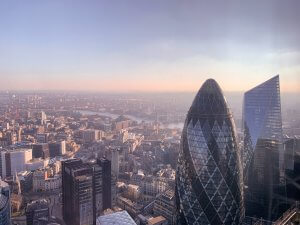What Effects Can City Life Have On Your Eyes?

Living and working in a big city like London can be great. The transport links are convenient, the food options are outstanding, and the nightlife is exceptional. But with all these benefits, city life can undoubtedly take a toll on our eyes. From air pollution and lighting to crowded underground stations and bright screens, our eyes face a barrage of stimuli, yet we barely even blink at the thought of long-term damage.
Thankfully, looking after our eyes in the big city doesn’t have to be a full-time job. So, let’s take a look at some of the common eye-related risks of city life – and what we can do to help prolong healthy vision for years to come.
Air Pollution
It’s no secret that air pollution is worse in urban areas. There are more cars, more buildings, and more people contributing to the deterioration of air quality. While the effects of such pollution are well-documented, many experts believe there is still a gap in our knowledge and awareness when it comes to its effects on our vision.
Several studies have linked air pollution to dry eye syndrome. While relatively common, this condition can be easily exacerbated when exposed to harsher environments, such as those in a big city. According to the London Air project based at Kings College, very high levels of air pollution may induce a dry throat, sore eyes, and a tickly cough, even in the healthiest of individuals.
And it’s not just out in the open that this can be a problem. Monitors placed in underground stations by Transport For London have found large particles of ‘toxic dust’ in the air — a particularly harmful substance that could penetrate the lungs and other organs including the liver, brain, and kidneys.
What You Can Do
Air pollution can be difficult to avoid altogether – particularly if you live or work in a city. But there are some steps you can take to minimise the effects on your vision, as well as your overall health.
- Wear sunglasses (wrap-around styles are best) to prevent pollutants from entering your eyes
- Avoid the tube when the temperature is high and pollution levels are at their peak
- Use lubricating eye drops to prevent soreness or itching
- Avoid wearing contact lenses, or if you need to wear them, remove the lenses at the first sign of eye irritation and thoroughly clean them in a medicated solution
If symptoms persist you should seek advice from your local optometrist. And don’t forget, as well as taking active precautions to protect your eyes on the tube, you can also check the London Air website to find out real-time pollution levels in your location.
In terms of prevention, staying hydrated can help stave off dry eyes and eating a healthy, balanced diet will help keep your eyes in good shape. Carrots, eggs, blueberries, and tomatoes are all great sources of eye-protecting nutrients.
Digital Eye Strain
Digital Eye Strain, also known as Computer Vision Syndrome (CVS), is a common condition that can cause a range of symptoms. It is caused by extended use of screens such as computers, smartphones, televisions, and tablets.
This prolonged screen time, which involves staring and straining to process text and images, can lead to headaches, neck pain, fatigue and dry eyes. And with many of us increasingly reliant on our screens in both our professional and personal lives, we may find ourselves more vulnerable. If unaddressed, digital eye strain can lead to permanent vision problems.
What You Can Do
The good news is that some simple changes can be very effective at reducing the risk of digital eye strain. Observing your posture, adjusting your screen settings and taking regular breaks can all help to prevent the symptoms of CVS. For more detailed advice on managing eye strain, take a look at our recent guide, “Eye Health: How to Avoid Eye Strain”
Long-Term Eye Care
There are many little things we can do every day to help maintain our eye health. But one of the most important things you can do is have a comprehensive eye exam. Furthermore, having regular eye tests can help to make sure any problems are identified as soon as possible, putting you in the best position for treatment.
To learn more about your eyes or to find out how Laser Eye Surgery could help to improve your vision, get in touch with one of our friendly clinic coordinators today. Alternatively, Book a comprehensive consultation appointment to start your journey to clear vision.


